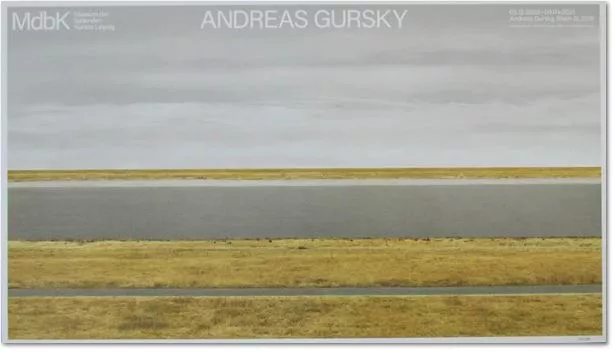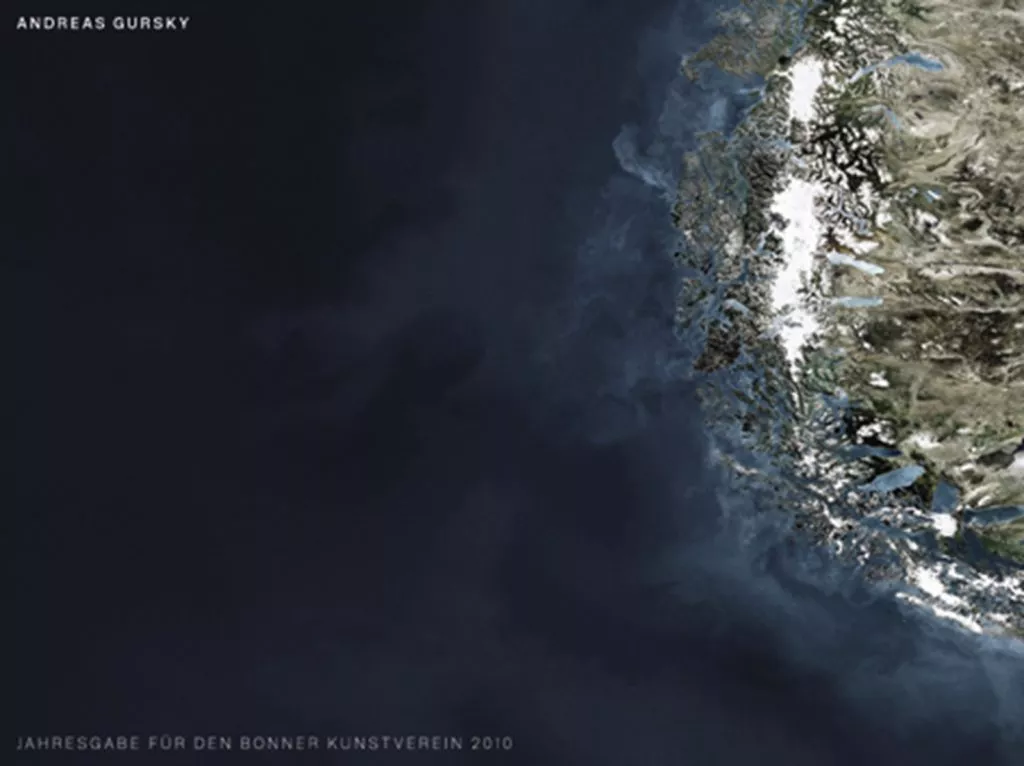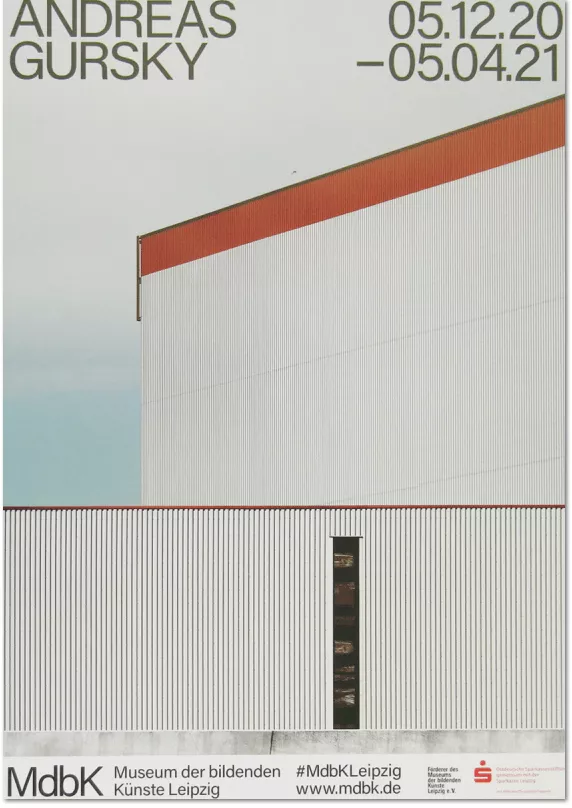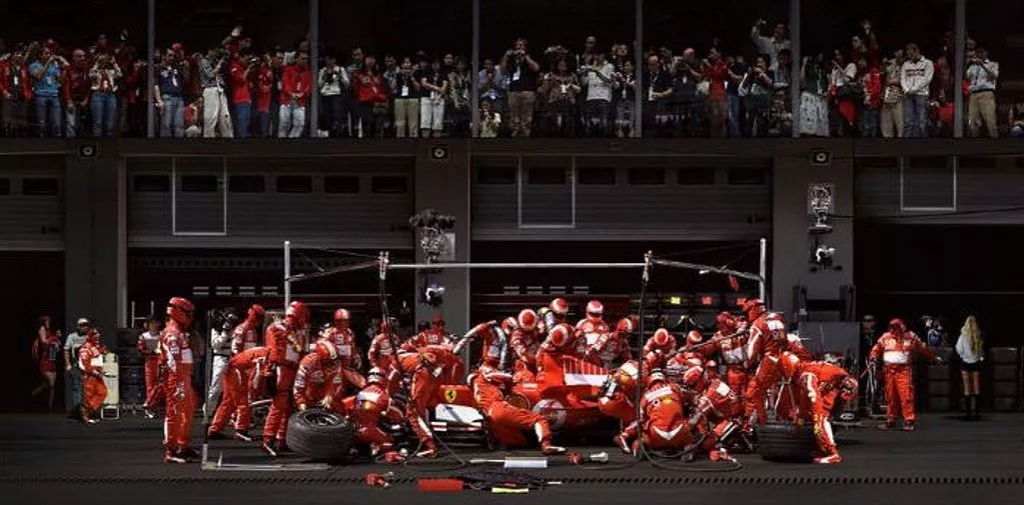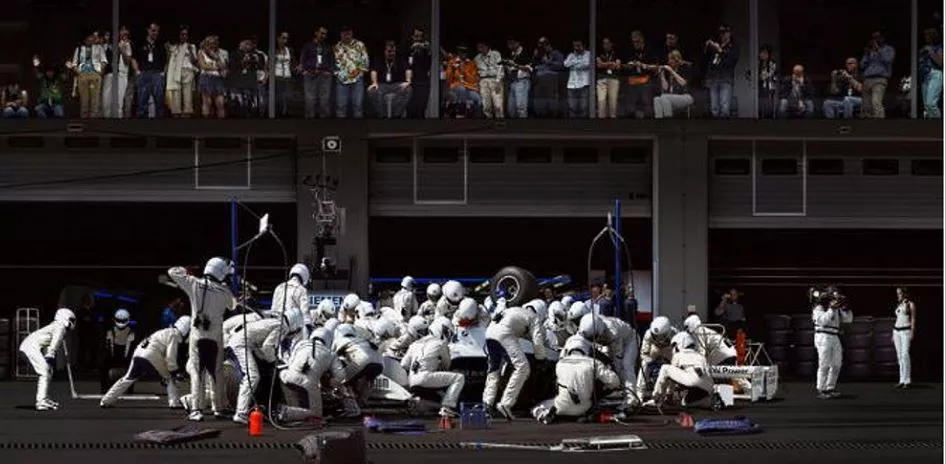This large colour photograph depicts a stretch of the river Rhine outside Düsseldorf. The image is immediately legible as a view of a straight stretch of water, but it is also an abstract configuration of horizontal bands of colour of varying widths. The horizon line bisects the picture almost exactly in the middle. Above it the overcast sky is a grey. In the bottom half of the image, the river is a glassy, unbroken band between green stripes of grass. At the bottom of the picture in the immediate foreground is a narrow path. Below it is another thin band of manicured green grass.
Gursky works with a medium format camera, taking pictures which he then scans into a computer where he can manipulate them. His aim in using digital technology is not to create fictions but rather to heighten the image of something that exists in the world. He has described the genesis of this work, saying, ‘there is a particular place with a view over the Rhine which has somehow always fascinated me, but it didn’t suffice for a picture as it basically constituted only part of a picture. I carried this idea for a picture around with me for a year and a half and thought about whether I ought perhaps to change my viewpoint … In the end I decided to digitalise the pictures and leave out the elements that bothered me’ (quoted in Annelie Lütgens, ‘Shrines and Ornaments: A Look into the Display Cabinet’,Andreas Gursky: Fotografien 1994-1998, p.xvi).
Gursky digitally erased buildings on the far side of the river from his picture. This manipulation enhances the image visually, giving it more formal coherence. Rather than the sense of a specific place, the picture conveys an almost Platonic ideal of a body of water traversing as landscape. Gursky talks about this image in terms of its contemporaneity, saying, ‘I wasn’t interested in an unusual, possibly picturesque view of the Rhine, but in the most contemporary possible view of it. Paradoxically, this view of the Rhine cannot be obtainedin situ; a fictitious construction was required to provide an accurate image of a modern river’ (quoted in ‘… I generally let things develop slowly’,Andreas Gursky: Fotografien 1994-1998, p.ix).
The Rhine IIrepresents a tendency in Gursky’s work towards abstraction. Throughout his career he has periodically made images whose formal and conceptual simplicity place them closer to the tradition of abstract art.Untitled I, 1993 is a close-up of an industrial carpet that recalls a grey monochrome painting. The grid-like ceiling depicted inBrasília, General Assembly I, 1994 has affinities with minimal objects.The Rhine shares with these earlier photographs an emphasis on textures; the distinctions between the shimmering gloss of the river, the smudged softness of the clouds, the lush carpet of the verges and the hard matte path lend the photograph sensual contrast.
Andreas Gursky, Poster for the exhibition Museum der Bildenden Künste, Leipzig, Motif: “Rhein III” 2018, colour offset on strong cardboard, size: 48 cm x 84 cm, numbered, limited edition 200 ex. SORRY SOLD
 Andreas Gursky: Bahrein, 2009, colour offset, handsigned by Andreas Gursky, published by Moderne Museet Stockholm, size: 100 cm x 70 cm. Condition: good to very good, Certificate of Authenticity. Price upon request.
Andreas Gursky: Bahrein, 2009, colour offset, handsigned by Andreas Gursky, published by Moderne Museet Stockholm, size: 100 cm x 70 cm. Condition: good to very good, Certificate of Authenticity. Price upon request.
Andreas Gursky, Poster published by Museum Frieder Burda, Baden-Baden, 2003, PCF Paris (Siège du Parti Communiste Francais), black / white offset, 84 cm x 59 cm, good condition. Price upon request.
Andreas Gursky: Ocean III, 2010, Ocean III is part of a series of seven works by Andreas Gursky. Gursky had the idea for this group of works during a flight to Australia, when he was observing the flight path of the aircraft. Land mass was only visible at the very edge of the monitor, which was mainly occupied by the blue emptiness of the ocean. Poster, colour offset, 59 x 42 cm, limited edition: 200 + 50 AP. SORRY, SOLD.
Andreas Gursky, 2020, Poster published for the exhibition Museum der bildenden Künste, Leipzig, Germany. Motif: Bauhaus, colour offset, 59 cm x 42 cm, good condition. Price upon request.
Andreas Gursky:“Untitled XV”, 2005, Orfficial Poster FiFA Worldcup 2005, limited edition of 800 pieces, hand-signed by Andreas Gursky and numbered X/800, size: 97 x 66 cm. Certificate of Authenticity. Price upon request.
Andreas Gursky: „F1 Pitstop“, Offsetprint, size: 40 x 120 cm, (15 ¾ x 47 ¼ inches), produced exclusively for the Exhibition “Andreas Gursky” in New York, 2007. Literature: Thomas Weski, Don deLilo: Andreas Gursky, 2007. Price upon request.
About this Artwork
F1 Pitstop, 2007, features four monumental images. Brilliant colors and compositional arrangement codify the flurry of organized but frantic activity of a Formula One pit row. The pit crews, placed underneath a long row of spectators, give the photographs a serene, tranquil balance despite the intense, frenzied event. The result is a typical Gursky effect, a detached aesthetic view of a spectacle that manages to retain its visual stability.
About Andreas Gursky
The big, bold, seductive and surprising color photographs of German photographer Andreas Gursky (* 1955) set forth a stunning image of our contemporary world of high-tech industry, international markets, big-time sports, fast-paced tourism and slick commerce. Tracking the zeitgeist from his native Germany to such far-flung places as Hong Kong, Brasilia, Cairo, New York, Shanghai, Stockholm, Tokyo, Paris, Singapore and Los Angeles, Gursky has earned acclaim at the leading edge of contemporary art with a polished signature style that draws upon a great diversity of ideas, precedents and techniques.
Details from Andreas Gursky: „F1 Pitstop“, Offsetprint:
Seething mechanics and technicians in bright team colours surround two vehicles in the pit stop. Above them, ranks of spectators look down from the hospitality suite like the heavenly host in a medieval frieze. The precise, neutral style creates a hushed reality: the sweaty, dust-streaked racing drivers have been removed from their earsplitting tarmac battle and placed in a balletic, tiptoeing mime. This is Formula One with the sound off.
F1 Boxenstopp is by German artist Andreas Gursky, whose luminous prints are now on show at two London galleries. His bold, large-format colour photographs (this one is a whopping 222cm x 608cm) are hot commodities. Already in 2007 one of his works sold for $2.48m (£1.27m), the highest price ever paid for a work by a living photographer.
This image might seem like an exceptionally crafted composition by a well-placed photographer, but it is in fact a minutely manipulated shot made up of elements from Grand Prix races around the world – Monte Carlo, Istanbul, Shanghai, São Paulo. The picture calls to mind Courbet’s large-scale painting A Burial at Ornans, its twin in size. Both artists give a banal scene the ambitious dimensions usually reserved for grand history paintings.
In his early fifties, Gursky is candid about his use of image manipulation, spending months in his Düsseldorf studio looking through reels and reels of film, adjusting colour, light and shade, sometimes one pixel at a time. He calls it “assisted realism”. The illusion is masterful, and at first sight, every picture seems a glimpse of the real world. Even when you register the seams, this impression is hard to shake off. It’s a little disorienting.
One of Gursky’s favourite themes is the opposition of the crowd and the individual. Within the mass, the human becomes pattern. Among the new works on display in London is the Pyongyang series (2007), for which Gursky travelled to the Arirang Festival in North Korea, held in honour of the late Communist leader Kim Il Sung.
The festival’s games include more than 50,000 participants performing tightly choreographed acrobatics. Gursky’s photographs describe the brilliant colours of this totalitarian spectacle. Get closer, and you can see smiling faces. It’s a sort of hyper-reality, so manically detailed that it makes your eyeballs sweat.
See more by ANDREAS GURSKY – Click here
